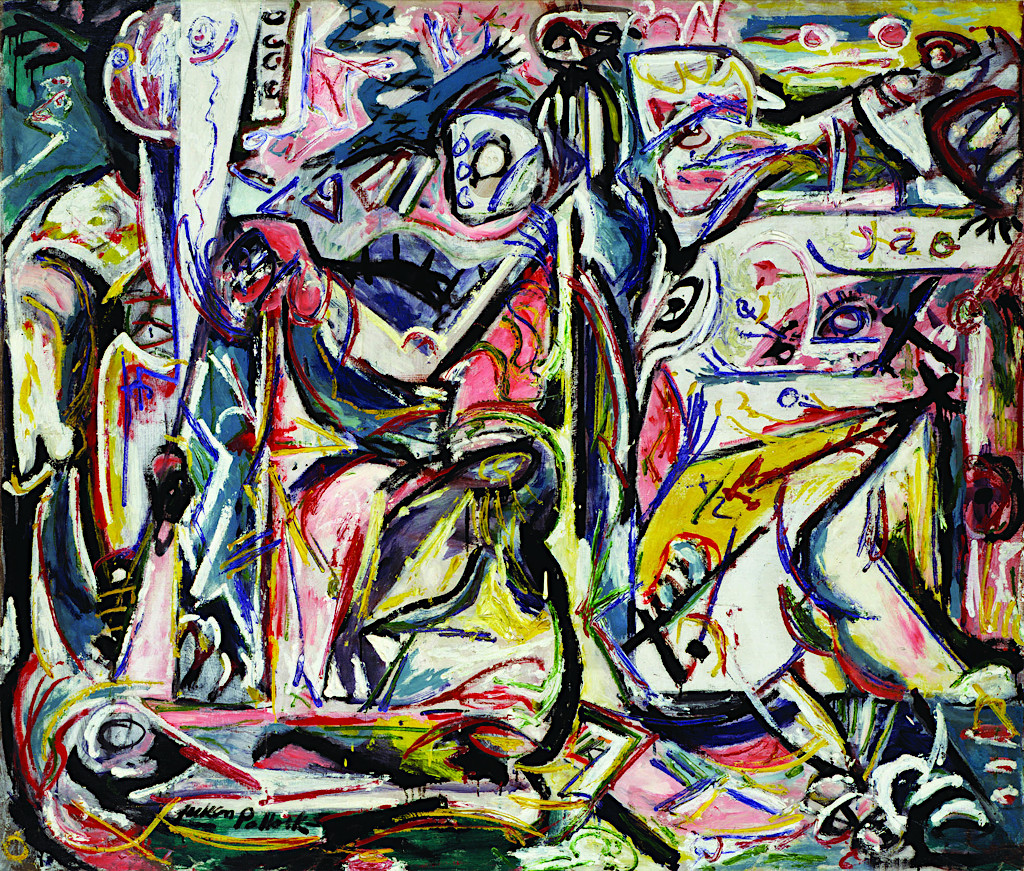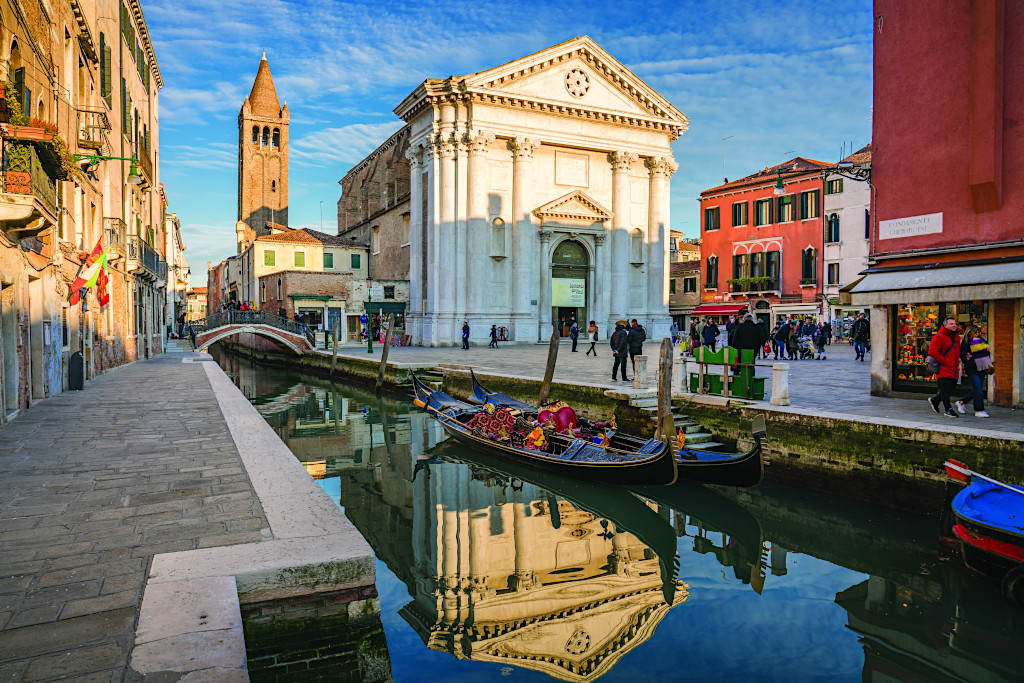Overcast but not raining we decided to walk over to the Peggy Guggenheim Museum, which was in our Dorsoduro neighborhood. Her palazzo is directly on the Grand Canal and although it isn’t on higher ground, the palazzo itself is built up on several feet of stone and I suspected they were safe from the flooding. I was right , and they were open. 2019 was the 40th anniversary of her death and the museum was honoring her with a special exhibit called The Last Dogaressa. On display was an eclectic array of sculptures, paintings, and drawings that she collected during the 30 years that she lived in her Palazzo Venier dei Leon, an 18th century palace. Shown were Jean Arp, Francis Bacon, Jackson Pollock and two of my favorites , David Hare’s sculpture, Moon Cage and Max Ernst’s Garden Airplane Trap.

The Peggy Guggenheim in Venice
Photo: Jo Crebbin
The next day the sun came out and so did all the Venetians and tourists! It was a perfect Autumn day to explore that year’s Biennale. Each year, the festival alternates between art and architecture, and 2019 celebrated art. It’s like the Olympics for the art world. That year’s theme was May You Live in Interesting Times, and 90 countries participated. Each country in the festival gets their own little pavilion. A real stand out this season was Russia’s contribution by artist Alexander Shishkin-Hokusai. I also really liked Ed Atkins Bloom. Also impressive was Kemang Wa Lehulere’s Dead Eye. And although it was hard to reach, Lorenzo Quinn, son of actor Anthony Quinn, offered another version of his giant hand sculptures to the Biennale.
“Venice is a World Heritage City and it is the city of bridges,” says Quinn. “It is the perfect location to spread a message of world unity and peace so that more of us around the world build bridges with others rather than walls and barriers.”
Sloshing through Venice, at one point we discovered ourselves in front of the Rialto Bridge. And right beside it was the department store, T Fondaco Dei Tedeschi. Inside the breathtakingly beautiful building built in 1228, we discovered on the first floor their restaurant Amo. We grabbed a perfect bite to eat, had a quick glass of wine, and we were ready to go.

Vestaglia by Alechinsky at the Peggy Guggenheim
Photo: Matteo De Fina
The following day, we noticed that the da Vinci Museum in our campo was open. 2019 marked the 500th anniversary of da Vinci’s death and to commemorate it, the Church of San Barnaba had a permanent collection on display. After the tide receded enough, we ran over and took a look at the meticulous recreations of da Vinci’s amazing plans for flight, combat, and even whimsy. There were levers, pulleys, wheels, axles, wedges, inclined planes, screws, gears, ball bearings, parachutes, and floats. His plans for a bicycle were spot on, but I’m not so sure about wings for man to fly.
On another “dry-ish” day we headed back to the Scuola Grande di San Riocco that we had tried to enter on the first day of the trip. Doors were open and so were our eyes—wide open! In 1564 the confraternity built the Scuola Grande and wanted religious paintings displayed throughout. Like its sister Church next door, that meant massive oil on canvas paintings on all the walls and ceilings of the two floors of the building. There was a competition held to find the right artist to do the work and Tintoretto, who wanted badly to be a part of the confraternity, played a big trick on the other artists. He secretly got into the Scuola and installed his completed painting on the ceiling! And he offered it for free, knowing the brotherhood could not refuse a charitable donation.

Circoncisione by Pollock at the Peggy Guggenheim
Photo: Matteo De Fina
So, San Rocco in Glory and Tintoretto won the competition. The following year he was offered membership into the brotherhood. It took him 24 years to complete the 50 enormous paintings on display at San Riocco. There are so many magnificent creations in this building, take your time to absorb and appreciate them all. Even come back a second or third time. Note: the museum offers mirrors for you to hold out in front of you so you can view the ceiling paintings without hurting your neck.
The day before we left Venice, the Gallerie Accademia finally reopened its doors. Here we found many Tintorettos, including his Saint Mark Saves the Slave from Torture. Tintoretto was only 29 when he painted this masterpiece. Saint Mark swoops down causing the instruments of torture to break, cancelling the punishment that the provencal lord (seated top right) had sentenced his slave to because he traveled to Venice to worship the remains of Saint Mark. There’s such movement in Tintoretto’s paintings, they appear cinematic. He was the first of the renaissance painters to include the everyday man and woman as well as rich lords and politicians. If you look closely, there are knights as well as Ottomans…only a Venetian could have painted this master work. And with a nod to Titian, Tintoretto gloriously paints silks, satins, and brocades in bold luscious colors. In a sense, he’s showing off Venice’s riches.

da Vinci Museum in Venice
Photo: Pajor Pawel
Also, of note is Saint Mark Saving a Saracen from Ship Wreck. Saint Mark rescues a converted Saracen. Yes, I needed to look up the meaning of Saracen (an Arab or Muslim). A stormy sea with foreboding sky streaked with lightening shows amazing movement and color, as Saint Mark effortlessly lifts the Saracen to safety.
What a perfect ending to a very unusual, exhilarating, and sometimes frightful trip to Venice…where it feels like Saint Mark has lifted the Venetian’s spirits up and encouraged their resilience and strength. It was devastating to walk the streets and witness shops, restaurants, museums, and hotels focusing on cleaning up the damage from the multiple floods. In fact, I have friends whose restaurants were still closed by the time I was flying back to NYC. I have such tremendous respect for Venice and its people, for their devotion to their exceptional city and their hard work ethic. My heart breaks for Venice. I don’t know what the future holds for her, but I will continue to return and rejoice in her splendor as long as I can. Ciao, Bella!.


